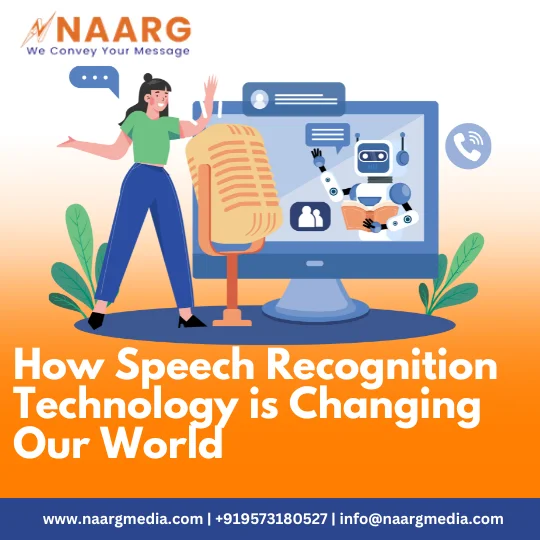Speech recognition technology—the technology that allows machines to understand and process human speech—has rapidly integrated into our lives. We are making everything from managing household tasks to navigating traffic more seamless and intuitive.
Let’s take our lives as an example; think about the last time you asked your virtual assistant ‘Siri’ or ‘Alexa’ to set a reminder, make a call, or find the nearest coffee shop. All these small interactions highlight the profound ways in which speech recognition is reshaping our daily routines.
And beyond just convenience, this speech recognition technology is revolutionizing industries, empowering visually impaired individuals with voice-controlled devices. Even assisting in real-time recognition and translation during international meetings. Speech recognition technology is no longer a novelty; it is transforming how we communicate, work, and live.
Want to understand how speech recognition technology is changing our world? Then read this blog as we explore the dynamics of this technology. And understanding how speech recognition is making waves across various sectors, making our world more efficient, accessible, and connected than ever before.

What is Speech Recognition Technology?
It is a groundbreaking innovation that enables machines to understand, interpret, and respond to human language. Speech recognition technology works by converting spoken words into digital data that computers can understand and process. Making it possible for us to interact with our digital devices using nothing but our voice commands.
This technology helps in our day-to-day lives, from activating smart home appliances with a simple command like ‘turn off the lights’ to conducting complex online searches without lifting a finger. This speech recognition technology is turning science fiction into everyday convenience.
Also, did you know that the speech recognition technology market is projected to be worth USD 15.46 billion in 2024 and will reach USD 84.97 billion by 2032? Thus exhibiting a CAGR of 23.7% during the forecast period of 2024-2032.
Furthermore, this technology blends advanced algorithms, machine learning, and artificial intelligence to achieve something truly remarkable. Thus bridging the gap between human communication and machine comprehension.
Evolution of Speech Recognition
The speech recognition technology journey began decades ago; it all started as a rudimentary concept and further evolved into the sophisticated systems we know today. Some of the earliest attempts can be traced back to the 1950s when Bell Laboratories designed the ‘Audrey’ system, which could recognize a limited set of spoken digits.
Then, by the 1960s and 1970s, further advancements continued with IBM’s ‘Shoebox,’ which understood a vocabulary of 16 English words, and DARPS’s ‘Harpy,’ which expanded the word recognition capabilities to over 1000 words.
Furthermore, it wasn’t until the late 1980s and 1990s that speech recognition began to gain serious momentum, thanks to the rise of powerful computer processors and the development of Hidden Markov Models (HMMs). These HMM models improved the accuracy of recognizing continuous speech, making a significant leap forward from isolated word recognition.
Then in the early 2000s, commercial applications like Dragon Naturally Speaking made speech-to-text tools available to consumers. Although they often required training and were limited by accent and dialect variations.
Now the real game changer came in the 2010s with the integration of machine learning and neural networks, allowing the systems to learn from vast datasets and adapt to different voices and languages more efficiently. Many companies, like Google, Apple, and Microsoft, entered the scene with voice assistants capable of understanding natural language commands.
Thus sparking the current era of ubiquitous, cloud-based speech recognition technology. And now, with the advances in deep learning, natural language processing (NLP), and artificial intelligence (AI), speech recognition systems can comprehend complex queries, recognize emotions, and even translate languages in real time.
This evolution in speech recognition technology will continue at a rapid pace, thus pushing the boundaries of what we once thought to be impossible in human-machine translation.
How Does Speech Recognition Work?
This speech recognition technology involves a series of complex steps that convert spoken words into digital texts or commands. We have listed below a simplified breakdown of how it works.
1. Audio Capture
Speech recognition works when the microphone of a device captures the spoken words or sounds. The raw audio input is often converted into a digital signal, which the system can process.
2. Pre-Processing
This digital signal is then cleaned up by filtering out background noise and normalizing the volume levels to ensure that the speech is clear and distinguishable.
3. Feature Extraction
This feature extraction system analyzes the cleaned audio to identify key features of the sound waves, like pitch, tone, and frequency. Feature extraction breaks down the audio into small segments or frames to capture phonemes, the basic units of sound in a language.
4. Acoustic Modeling
Then these extracted features are compared against an acoustic model, a statistical representation of the phonemes in a given language. This acoustic model helps identify which phonemes match the audio signal most closely.
5. Language Modeling
Next, after identifying the phonemes, the system uses a language model to predict the most likely words and phrases based on the context. This language model is trained on vast datasets of text to understand syntax, grammar, and common word sequences.
6. Decoding
Then the language and acoustic models work together to decode the speech into a text output. The system considers multiple possibilities and then selects the most probable word sequence based on its training.
7. Post-Processing
This decoded text is refined for accuracy. This step may involve correcting grammatical errors, adjusting for context, or using additional algorithms to fine-tune the results.
8. Output Generation
Lastly, the recognized text is outputted to the user. This particular text can be displayed on a screen, converted into a command for a device, or used to perform a specific action, like sending a message or executing a search query.
Real-World Applications of Speech Recognition Technology
As we know, speech recognition technology has evolved far beyond simple voice commands, finding a place in countless aspects of our daily lives.
So, we have listed some of the most impactful real-world applications.
1. Virtual Assistants
Various services like Amazon, Apple Siri, Google Assistant, and Microsoft Cortona use speech recognition to perform different tasks like setting reminders, controlling smart home devices, playing music, and providing real-time information like weather updates or traffic reports.
These virtual assistants have become integral to smart homes, making everyday tasks more convenient through voice commands.
2. Healthcare
In the healthcare industry, speech recognition is revolutionizing patient care and administrative processes. Healthcare professionals and doctors use dictation tools to transcribe patient notes, medical histories, and prescriptions, reducing paperwork.
Thus allowing them to focus more on patient interaction. This also helps create accurate electronic health records (EHRs) quickly, which improves communication and data sharing within healthcare teams.
3. Customer Service
Different companies are implementing speech recognition in their customer service systems to automate responses, route calls efficiently, and handle basic customer inquiries without any human intervention.
These automated customer service agents can understand and respond to common queries, reducing wait times and improving customer satisfaction.
4. Usability for People with Disabilities
Speech recognition technology is empowering people with disabilities by providing hands-free control over devices. For physically disabled individuals or visually impaired individuals, voice commands offer an accessible way to navigate the web, use apps, send messages, or even control smart home environments.
Improving their freedom and standard of living in the process.
Benefits of Speech Recognition Technology
The benefits of speech recognition technology are numerous and are reshaping how we interact with digital devices and services.
Here are a few of the main advantages.
1. Increased Efficiency and Productivity
Speech recognition allows users to perform tasks hands-free and faster than typing. It significantly boosts productivity, from dictating emails and documents to searching the web or navigating apps.
The users can accomplish more in less time, freeing them from the constraints of manual data entry.
2. Enhanced Accessibility
It provides a valuable tool for people with disabilities, as it enables individuals with visual impairments or motor difficulties to interact with technology using voice commands.
Thus breaking down barriers and promoting inclusivity. This speech recognition technology helps users perform everyday tasks independently, like sending messages, controlling smart devices, or browsing the internet.
3. Hands-Free Operation and Safety
There are many scenarios where hands-free operation is essential, like driving, and then this speech recognition technology plays a crucial role in improving safety.
Allowing drivers to control navigation, make calls, or send texts without taking their hands off the wheel. As it reduces distractions and minimizes the risk of accidents.
The Future of Speech Recognition Technology
As we talk about the future of speech recognition technology, it is quite evident that it is set to be nothing short of transformative. Unlocking new possibilities for how we live, work, and interact with the world around us. As there are further advancements in artificial intelligence, machine learning, and natural language processing, speech recognition systems will become more accurate, intuitive, and context-aware.
There will be virtual assistants that understand not just words but also emotions, intentions, and subtle nuances in tone. Thus enabling them to provide even more personalized and meaningful responses. Shortly, we may see speech recognition integrated into every aspect of our daily lives, from voice-activated devices that anticipate our needs before we even speak.
Who knows!
This might happen in the future. With all the rapid advancements that are going on in technology, this might be a possibility. But one thing is for sure: as speech recognition technology advances, it promises to redefine our relationship with technology. Eventually making it more human-like, inclusive, and seamlessly woven into the fabric of our everyday experiences.
Whatever the case, we should be ready with open hands and minds to accept all these future advancements in speech recognition technology.
Now don’t just talk about the future—start shaping it today. Dive deeper, stay informed, and be a part of the voice revolution.
Don’t let language stand in your way—partner with Naarg today and discover the future of communication.
Contact us today to learn more and get started.

